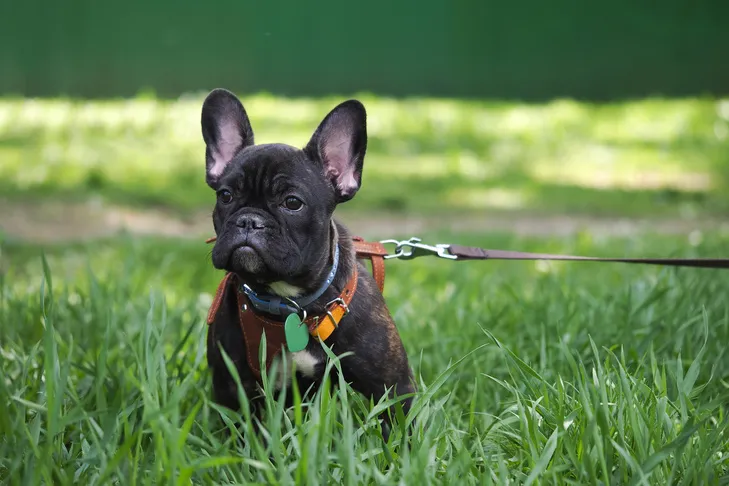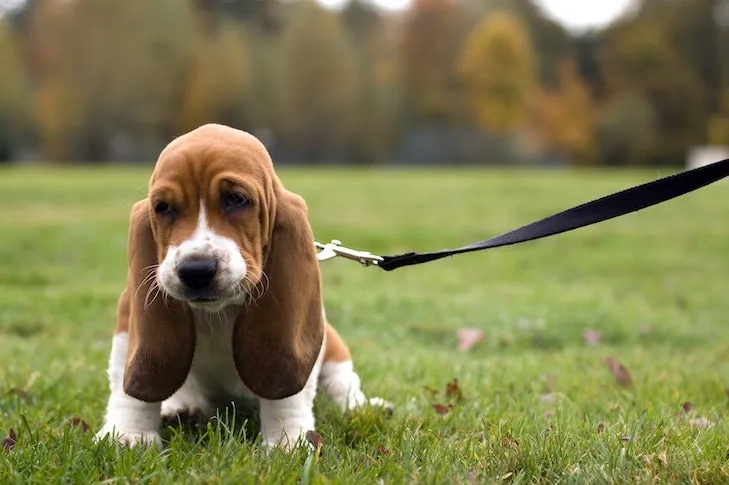Many new puppy owners believe that dogs instinctively know how to walk politely on a leash. However, this essential skill is developed through consistent training, and it’s a practice you’ll undoubtedly value on every outing with your canine companion. Knowing when to use a leash on your puppy is the first step towards building good habits and ensuring safety. Dog training expert and AKC Family Dog training and behavior columnist Kathy Santo emphasizes the importance of early intervention and proper technique to set a solid foundation.
Starting leash training early allows your puppy to become comfortable with the sensation of wearing a collar or harness and the gentle guidance of a leash. This process not only teaches them proper walking etiquette but also helps strengthen your bond and establishes clear communication. A well-trained puppy on a leash is a joy to walk, making outdoor adventures more pleasant for both of you.
Understanding the right time and methods for introducing the leash will pave the way for successful walks and a well-behaved companion. If you’re looking for guidance on getting your young pup accustomed to their walking gear, explore how to get my puppy used to a leash. This guide will walk you through the initial steps and lay the groundwork for effective training.
Training Your Puppy to Walk on a Leash
Establishing a solid foundation for leash walking is crucial for your puppy’s development and your shared experiences. This process involves several progressive steps, each building upon the last to ensure your puppy understands and enjoys their time on the leash. These early training experiences are vital for shaping a well-behaved dog and making future walks stress-free.
Introduce the Collar or Harness and Leash
The very first step in determining when to use a leash on your puppy is to acclimate them to wearing the equipment. Begin by introducing them to a comfortable collar or harness and a lightweight leash. Allow your puppy to wear these items for short periods while indoors, especially during playtime or treat sessions. The goal is for your puppy to associate wearing their gear with positive experiences, such as food and fun. This positive association is foundational for all subsequent training. For a broader understanding of early training, consider reviewing puppy training basics the first week to ensure a smooth start.
Teach a Communication Cue
Introduce a consistent sound cue that signals “food is coming.” This could be a clicker, a verbal “yes,” or even a specific tongue cluck. In a quiet, distraction-free environment, with your puppy wearing their leash and collar, make the sound. The instant your puppy looks at or turns towards you, reward them with a small, high-value treat. After a few repetitions, your puppy will not only look at you but also begin to move towards you in anticipation of the treat, establishing an early form of communication and focus.
Encourage Your Puppy to Come to You
Once your puppy understands the sound cue, start to incorporate movement. While they are on their way to you, still wearing their leash and collar, back up a few paces. Reward them immediately when they reach you. Gradually increase the distance, always rewarding them when they follow your movement after hearing the cue. Continue this progression until your puppy reliably comes to you and walks a few paces alongside you upon hearing the cue noise. Remember, puppies have short attention spans, so keep sessions brief and positive, ending before they become mentally exhausted. For more detailed guidance on this essential command, learn how to teach a puppy to come effectively.
Practice Inside for Controlled Learning
Now that your puppy understands the concept of coming to you, practice walking a few steps in a room with minimal distractions. The sensation of the leash around them will be enough of a challenge in this controlled environment. Offer plenty of treats and praise as your puppy learns to walk with you while on a leash. This indoor practice builds confidence and reinforces the desired behavior before introducing the complexities of the outside world.
Transition to Outdoor Walks
Finally, you’re ready to test your puppy’s skills in the great outdoors. This step presents new challenges due to the multitude of sounds, smells, and sights that will intrigue your puppy. Be patient and keep initial outdoor walks short. While walking, continuously observe your puppy. If they appear about to lunge or become distracted, use your cue sound and move a few steps away, then reward them with a treat for following you. Maintaining constant awareness of your puppy’s focus is key to successful outdoor training.
 French bulldog puppy in a harness sitting in tall green grass on a leash for a walk.
French bulldog puppy in a harness sitting in tall green grass on a leash for a walk.
Troubleshooting Common Leash Issues
Even with consistent training, you might encounter specific challenges as your puppy matures, explores new environments, and faces new distractions. Addressing these issues proactively is essential for developing a well-behaved, loose-leash walker who can even pass tests like the Canine Good Citizen. The AKC GoodDog! Helpline offers valuable insights into these common problems.
When Your Puppy Pulls on the Leash
If your puppy starts pulling in the opposite direction, immediately stop and become “a tree.” Stand completely still and refuse to move forward until your puppy returns to your side. Avoid yanking or jerking the leash or dragging your dog. This method teaches them that pulling gets them nowhere. For persistent pullers, alternative training tools like front-hook harnesses or head halters can provide more control and discourage pulling behavior effectively.
When Your Puppy Lunges at Distractions
If your puppy attempts to lunge at specific targets during a walk—such as other dogs, cars, or skateboarders—proactive intervention is critical. Try to redirect their attention with a treat before they have the chance to lunge. Increase the space between your dog and the target of their interest. Staying alert and being prepared before potential triggers get too close can prevent the lunge. While more common in herding breeds, any dog can be startled or excited by new stimuli. Integrating solid obedience into your walks can significantly reduce these instances, so ensuring your puppy knows top commands to teach puppy can be incredibly beneficial.
When Your Puppy Barks Excessively
Some dogs develop a habit of barking at other dogs or passersby while on a walk. This behavior often stems from a lack of sufficient mental and physical stimulation. Ensure your dog receives an appropriate amount of exercise for their age and breed. If barking remains an issue, employ the same process as with lunging: create distance and offer treats before they start to bark. This helps them associate the sight of other dogs with turning their attention to you and receiving a reward. Consistent reinforcement will gradually reduce the need for treats and extensive troubleshooting during your walks. Similarly, managing other undesirable behaviors like how to stop my puppy from jumping on me involves consistent redirection and positive reinforcement.
 Basset Hound puppy sitting in green grass with a leash attached.
Basset Hound puppy sitting in green grass with a leash attached.
Conclusion
Understanding when to use a leash on your puppy and how to implement effective training techniques from an early age is paramount for fostering a well-behaved and confident canine companion. By gradually introducing the leash, establishing clear communication cues, and consistently practicing in varied environments, you can ensure that walks become an enjoyable experience for both of you. Addressing common challenges like pulling, lunging, and barking with patience and proactive strategies will further solidify good leash manners.
Remember to keep training sessions positive, short, and engaging, always ending on a high note. The investment in early leash training not only ensures your puppy’s safety but also strengthens the bond you share, making every adventure together a pleasure. If you find yourself needing more personalized guidance, expert help is available. Training your dog can be challenging without professional support, which is why services like the AKC GoodDog! Helpline offer virtual access to professional trainers for unlimited, individualized advice on everything from house-training to behavioral issues.
